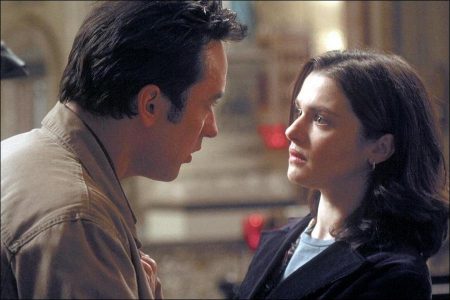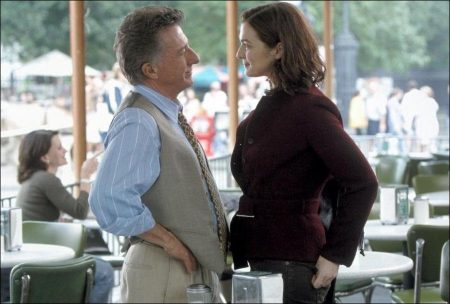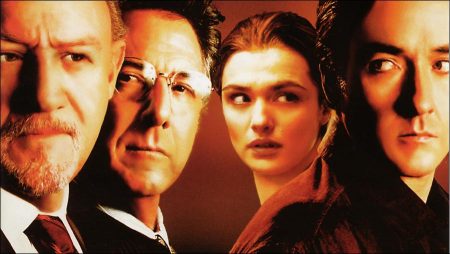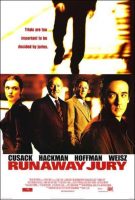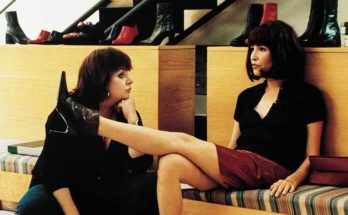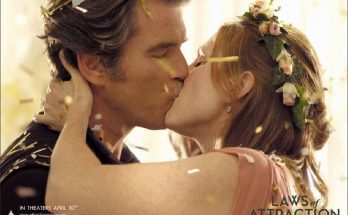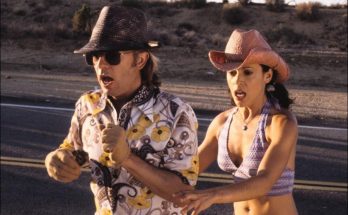Tagline: Trials are too important to be decided by juries.
From master storyteller John Grisham (The Firm, The Pelican Brief) comes Runaway Jury, a suspense-thriller about a high-priced and ruthless jury “consultant” (Gene Hackman) who will stop at nothing to secure a verdict on an explosive trial. With lives and millions of dollars at stake, the fixer wages a deadly battle with a jury member (John Cusack), a mysterious woman (Rachel Weisz) and an honest lawyer (Dustin Hoffman). The film marks the first pairing of screen legends Gene Hackman and Dustin Hoffman.
When a young widow in New Orleans brings a civil suit against the powerful corporate consortium she holds responsible for her husband’s murder, she sets in motion a multi-million dollar case. But it’s a suit that may be won even before it begins – based solely on the selection, manipulation and, ultimately, the attempted “theft” of the jury.
Representing the widow is Wendall Rohr (Hoffman), a courtly Southern lawyer with a moral center and a heartfelt passion for the case he’s presenting. His opponent is ostensibly the attorney representing the corporation. But in reality, defense counsel is only the front man for Rankin Fitch (Hackman), a brilliant and ruthless jury consultant.
At a high tech command center set up in an old French Quarter warehouse, Fitch and his team work on the surveillance and assessment of potential jurors. He will know everything about their lives, and strategically manipulate the jury selection process. The only acceptable result is the perfect jury to vote in favor of his client.
Fitch and Rohr soon realize they’re not the only ones out to win the jury. One of the jurors, Nick Easter (Cusack), seems to have his own plan for swaying the panel. And a mysterious woman known only as Marlee (Weisz) contacts both Rohr and Fitch telling them the jury’s for sale to either of them – and that the verdict won’t come cheap.
While the case is argued in court, a dangerous cat and mouse game begins to play out in New Orleans’ French Quarter. Rohr’s morality put to the test, and Fitch is poised to cross the line from selecting a jury to stealing it – no matter who gets hurt in the process.
Producer (and Regency Enterprises founder) Arnon Milchan’s passion for RUNAWAY JURY dates back to the publication of John Grisham’s best-selling novel in 1996. Having previously produced two successful Grisham adaptations – “A Time to Kill” and “The Client” – Milchan thought RUNAWAY JURY’s compelling story and surprising plot twists could be turned into an powerful movie.
When Gary Fleder, who helmed Regency’s hit thriller “Don’t Say a Word,” agreed to direct RUNAWAY JURY, Milchan was ready to move the project toward production. Fleder appreciated that RUNAWAY JURY couldn’t be pigeon-holed in a genre. “It’s not simply a courtroom drama and it’s not strictly a thriller,” explains the director. “For me, the hook is that it’s a heist movie in a courtroom; it’s about the theft of a jury.
“In our movie, there are several people trying to steal a jury. Not win a jury, but steal it. That’s the objective of Nick and Marlee, played by John Cusack and Rachel Weisz, as well as the powerful jury consultant Rankin Fitch, played by Gene Hackman. And ultimately, it might even be the objective of decent and compassionate attorney Wendall Rohr, played by Dustin Hoffman. A heist movie in a courthouse is something I’d never seen before.”
Fleder and Milchan were passionate about this aspect of the story. “For us,” says Fleder, “RUNAWAY JURY was less about a trial about the specific nature of the trial, and more about the idea of rigging and controlling over a jury. “In Grisham’s body of work this is a unique story. It isn’t David vs. Goliath; there isn’t the typical underdog. It’s a much more morally ambiguous piece.”
The character of Rankin Fitch was another key selling point for the filmmakers. “He’s someone who’s self-aware and smart and, therefore, daunting,” says Fleder. “Fitch is a great character because he has his own moral center which happens to be one not shared by most people.”
The script’s moral ambiguity was yet another draw. RUNAWAY JURY’s characters are not painted in black-and-white as clear-cut good guys and bad guys but rather in shades of gray. “RUNAWAY JURY challenges the audience because the film isn’t clear about who’s ‘good’ and who’s ‘evil’,” says Fleder. “Fitch is antagonist, but Nick and Marlee are involved with jury manipulation as well.’
For the role of juror Nick Easter, Fleder thought John Cusack would be ideal. “I had a very short list of actors for this manipulative, charming and funny character,” says Fleder. Fleder’s first choice was Cusack whose work he has always admired. “John has a great balance of charm and humor, but also has an edge and a dark side.”
RUNAWAY JURY’s twists and turns and the complexity of the Nick Easter character were the project’s principal attractions for Cusack. “The focus on jury tampering makes it a drama that hasn’t been done before,” says Cusack. “It’s really two different movies; it looks and has the flavor of a courtroom drama, but there are other things going on. For me, the movie is about greed, obstruction of justice and how the system has become corrupted. It’s also a movie about human nature and manipulation.”
Runaway Jury (2003)
Directed by: Gary Fleder
Starring: John Cusack, Gene Hackman, Dustin Hoffman, Rachel Weisz, Bruce McGill, Jeremy Piven, Jennifer Beals, Melora Walters, Marguerite Moreau, Joanna Going
Screenplay: Brian Koppelman, David Levien
Production Design by: Nelson Coates
Cinematography by: Robert Elswit
Film Editing by: William Steinkamp
Costume Design by: Abigail Murray
Set Decoration by: Tessa Posnansky
Music by: Christopher Young
MPAA Rating: PG-13 for violence, language, thematic elements.
Distributed by: 20th Century Fox
Release Date: October 17, 2003
Views: 55
